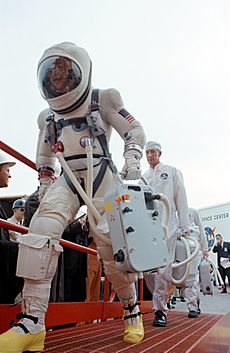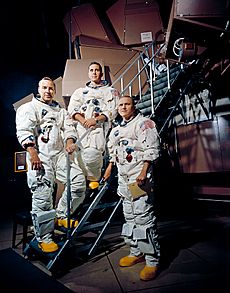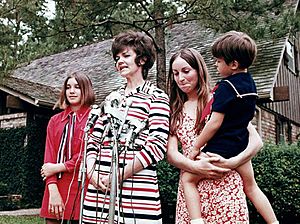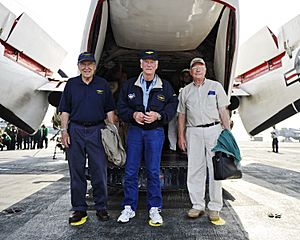Jim Lovell facts for kids
Quick facts for kids
Jim Lovell
|
|
|---|---|
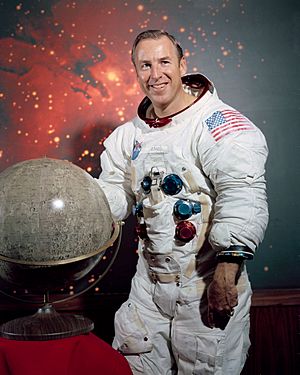
Lovell in 1969
|
|
| Born |
James Arthur Lovell Jr.
March 25, 1928 Cleveland, Ohio, U.S.
|
| Died | August 7, 2025 (aged 97) Lake Forest, Illinois, U.S.
|
| Space career | |
| NASA astronaut | |
|
Time in space
|
29 days, 19 hours, 5 minutes |
| Selection | NASA Group 2 (1962) |
| Missions | |
|
Mission insignia
|
   |
| Retirement | March 1, 1973 |
| Military career | |
| Branch | United States Navy |
| Years | 1952–1973 |
| Rank | Captain |
| Unit | VC-3, VF-101 |
James Arthur "Jim" Lovell Jr. (March 25, 1928 – August 7, 2025) was a famous American astronaut, naval pilot, and engineer. He is remembered as one of the first people to ever fly to the Moon. He is most famous for being the commander of the Apollo 13 mission, which had a dangerous emergency in space but returned to Earth safely thanks to the crew's skill and teamwork.
Lovell flew in space four times. In 1968, he was part of the Apollo 8 crew, the first mission to orbit the Moon. This made him, along with Frank Borman and William Anders, one of the first three humans to see the far side of the Moon. He is one of only three people to have flown to the Moon twice. For his bravery, he received many awards, including the Presidential Medal of Freedom. His amazing story was told in the book Lost Moon and the popular 1995 movie Apollo 13.
Contents
Early Life and Education
James Arthur Lovell Jr. was born in Cleveland, Ohio, on March 25, 1928. As a boy, his family moved to Milwaukee, Wisconsin. He was an Eagle Scout, the highest rank in the Boy Scouts. From a young age, he was fascinated by rockets and enjoyed building and flying model rockets.
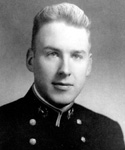
After high school, Lovell attended the University of Wisconsin–Madison. He was part of a special Navy program that helped him pay for college. He later decided to apply to the famous United States Naval Academy in Annapolis, Maryland. He graduated in 1952 with a degree in science and was commissioned as an officer in the Navy.
While in college, he married his high school sweetheart, Marilyn Gerlach, in 1952. They had four children together.
After graduating, Lovell became a pilot in the United States Navy. He learned to fly fighter jets, including the McDonnell F2H Banshee. He even practiced the difficult task of landing on aircraft carriers at sea.
In 1958, he trained to become a test pilot. Test pilots fly new and experimental aircraft to make sure they are safe. He graduated at the top of his class. His classmates included other future astronauts like Wally Schirra and Pete Conrad.
Later, Lovell was one of 110 pilots considered for Project Mercury, America's first program to send humans to space. He wasn't chosen at first because of a temporary medical issue, but he didn't give up on his dream of becoming an astronaut.
A Journey into Space with NASA
In 1962, NASA was looking for its second group of astronauts for the upcoming Gemini and Apollo missions. Lovell applied again and this time he was accepted. He became part of a group of nine new astronauts known as the "Next Nine".
Project Gemini: Learning to Fly in Space
The Gemini program was designed to figure out how astronauts could work in space for long periods and practice the skills needed to go to the Moon. Lovell flew on two Gemini missions.
Gemini 7: A Long Time in Space
In December 1965, Lovell flew on Gemini 7 with Frank Borman. Their main goal was to see if humans could live in space for 14 days, the time it would take for a round trip to the Moon. They set a record for the longest spaceflight at the time.
During their mission, they also performed the first-ever space rendezvous with another spacecraft, Gemini 6A. The two capsules flew side-by-side, sometimes just a foot apart. This proved that spacecraft could meet and dock in orbit, a key skill for the Apollo missions.
Gemini 12: Mastering the Spacewalk
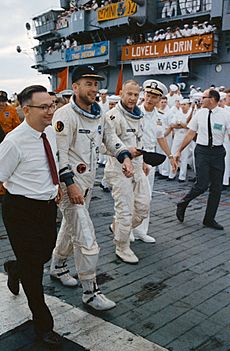
Lovell's second spaceflight was as commander of Gemini 12 in November 1966, with pilot Buzz Aldrin. The main goal of this mission was to perfect extravehicular activity (EVA), also known as a spacewalk. On earlier missions, astronauts had found it very difficult to work outside the spacecraft.
For Gemini 12, NASA added new handrails and foot restraints to the outside of the capsule. Aldrin also practiced for the mission by training underwater, which is very similar to moving in zero gravity. During the flight, Aldrin performed three successful spacewalks, proving that astronauts could work outside their ships effectively.
The Apollo Program: Reaching for the Moon
After the success of Gemini, NASA was ready for the Apollo program, with the ultimate goal of landing a man on the Moon.
Apollo 8: First to Orbit the Moon
In December 1968, Lovell joined Frank Borman and William Anders on the historic Apollo 8 mission. Lovell's job was command module pilot, which meant he was the expert navigator for the trip. They were the first humans to launch on the powerful Saturn V rocket and the first to travel all the way to the Moon.
On Christmas Eve, they entered orbit around the Moon. They became the first people to see the Earth rise over the lunar surface and the first to see the mysterious far side of the Moon. They broadcast live television pictures back to Earth and read from the Book of Genesis, a message of peace that was heard by millions. When Mission Control re-established contact after they fired their engine to come home, Lovell famously said, "Please be informed, there is a Santa Claus."
Apollo 13: A Successful Failure
Lovell's fourth and final mission was as commander of Apollo 13 in April 1970. He was joined by Jack Swigert and Fred Haise. Their goal was to make the third landing on the Moon. Lovell and Haise were set to walk in a region called the Fra Mauro formation.
Two days into the flight, disaster struck. An oxygen tank in the Service Module exploded, crippling their spacecraft, the Odyssey. With their power and oxygen running out, a Moon landing was impossible. The new mission was just to get home alive.
"Houston, we've had a problem," Lovell famously reported to Mission Control.
The crew moved into their Lunar Module, the Aquarius, using it as a "lifeboat." It had limited power and oxygen, but it was their only chance. Working closely with engineers in Houston, the crew had to conserve power, deal with freezing temperatures, and solve a dangerous problem with rising carbon dioxide levels. Lovell had to manually steer the spacecraft for two crucial engine burns to get them on the right path back to Earth.
After several tense days, the crew safely splashed down in the Pacific Ocean on April 17. Although they never made it to the Moon, the Apollo 13 mission is remembered as one of NASA's finest moments, a "successful failure" that showed incredible teamwork and bravery.
Life After NASA
Lovell retired from NASA and the Navy in 1973. He became a successful businessman in the communications industry.
In 1994, he co-wrote the book Lost Moon about his experience on Apollo 13. This book was turned into the hit movie Apollo 13 in 1995, starring Tom Hanks as Lovell. Lovell himself appeared in the movie in a small role as the captain of the ship that rescues the astronauts.
His wife, Marilyn, died in 2023. They were married for over 70 years. Lovell died at his home in Lake Forest, Illinois, on August 7, 2025, at the age of 97. After his death, NASA praised his "calm strength under pressure" that helped bring the Apollo 13 crew home safely.
Awards and Honors
For his service and bravery, Jim Lovell received many of the nation's highest honors. These include the Congressional Space Medal of Honor and the Presidential Medal of Freedom. He also received the Navy Distinguished Service Medal and the NASA Distinguished Service Medal.
He was inducted into the U.S. Astronaut Hall of Fame in 1993. In his honor, a small crater on the far side of the Moon was named Lovell.
Jim Lovell quotes
- "There are people who make things happen, there are people who watch things happen, and there are people who wonder what happened. To be successful, you need to be a person who makes things happen."
- "The vast loneliness is awe-inspiring and it makes you realize just what you have back there on Earth."
- "Be thankful for problems. If they were less difficult, someone with less ability might have your job."
- "The lunar flights give you a correct perception of our existence. You look back at Earth from the moon, and you can put your thumb up to the window and hide the Earth behind your thumb. Everything youve ever known is behind your thumb, and that blue-and-white ball is orbiting a rather normal star, tucked away on the outer edge of a galaxy."
- "Houston, we've had a problem here."
See also
 In Spanish: James A. Lovell para niños
In Spanish: James A. Lovell para niños


